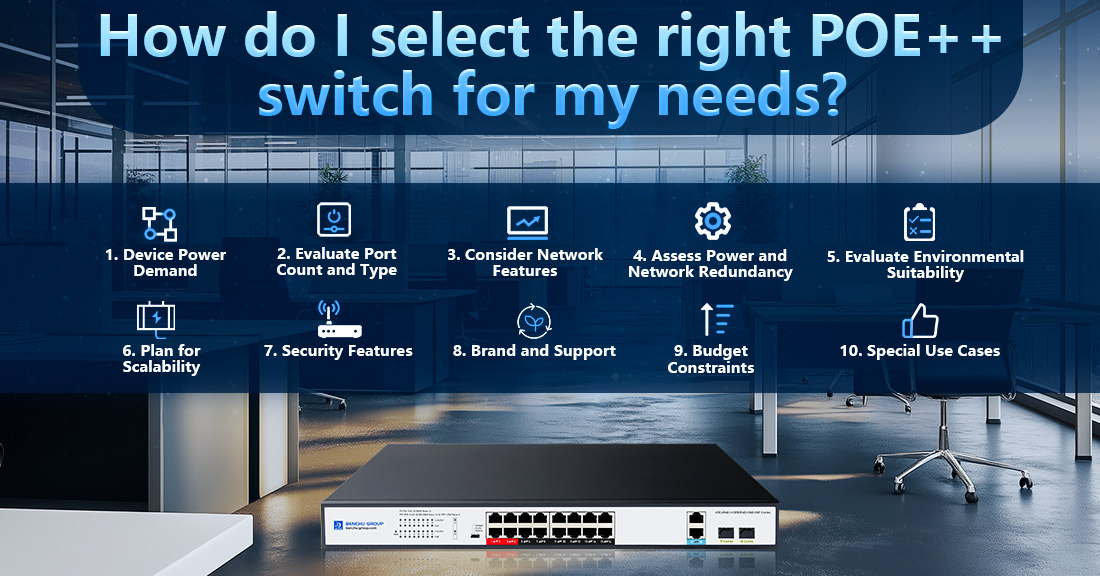
Selecting the right PoE++ switch involves evaluating your specific requirements, including power needs, network size, device compatibility, and future scalability. PoE++ switches, which adhere to the IEEE 802.3bt standard, are capable of delivering up to 100W per port, making them ideal for high-power devices. To ensure the best choice for your needs, consider the following factors:
1. Determine the Power Requirements of Connected Devices
Device Power Demand:
--- Identify the power requirements of the devices to be connected (e.g., IP cameras, wireless access points, LED lighting, or smart devices).
Typical device power needs:
--- PoE (IEEE 802.3af): Up to 15.4W
--- PoE+ (IEEE 802.3at): Up to 30W
--- PoE++ (IEEE 802.3bt): Up to 60W (Type 3) or 100W (Type 4)
Power Budget:
Calculate the total power budget required by summing the power needs of all devices. For example, if you have:
--- 5 devices requiring 30W each = 150W total.
--- 2 devices requiring 90W each = 180W total.
Choose a switch with a total power budget greater than your requirement to avoid overloading.
2. Evaluate Port Count and Type
Number of Ports:
--- Match the number of PoE++ ports on the switch to the number of devices you plan to connect.
--- Small networks: 4-8 ports.
--- Medium to large networks: 16, 24, or 48 ports.
Uplink Ports:
--- Ensure the switch includes uplink ports (e.g., SFP or SFP+ for fiber connections) if you need high-speed connections to a core switch or other network segments.
Port Speed:
--- Verify that the switch supports sufficient speed for your devices, such as Gigabit Ethernet for most applications or 10-Gigabit Ethernet for high-performance needs.
3. Consider Network Features
Managed vs. Unmanaged Switches:
Managed Switches:
--- Allow you to configure and monitor your network.
--- Provide advanced features such as VLANs, Quality of Service (QoS), and bandwidth control.
--- Ideal for complex setups with multiple devices.
Unmanaged Switches:
--- Plug-and-play operation with no configuration required.
--- Best for small, straightforward networks.
Layer 2 or Layer 3:
--- For simple networks, a Layer 2 PoE++ switch is sufficient.
--- For advanced routing capabilities, such as inter-VLAN communication or static/dynamic routing, consider a Layer 3 PoE++ switch.
4. Assess Power and Network Redundancy
Redundant Power Supplies:
--- Look for switches with redundant power supply support if uptime is critical (e.g., surveillance or emergency systems).
Power Allocation:
--- Choose switches with intelligent power management to allocate power efficiently to connected devices.
Network Redundancy:
--- Features like link aggregation or stacking allow for increased reliability and bandwidth.
5. Evaluate Environmental Suitability
Indoor vs. Outdoor Use:
--- Standard PoE++ switches are suitable for indoor environments like offices or data centers.
--- Industrial PoE++ switches are designed for harsh environments with extreme temperatures, dust, or moisture (e.g., IP-rated or fanless designs for silent operation).
6. Plan for Scalability
Current vs. Future Needs:
--- Choose a switch that not only meets your current needs but can accommodate future expansions (e.g., more ports, higher power budget).
Power Budget Growth:
--- Select a switch with a larger power capacity if you anticipate adding high-power devices in the future.
7. Security Features
Look for switches with:
--- Port security to prevent unauthorized access.
--- Access Control Lists (ACLs) to regulate network traffic.
--- 802.1X authentication for enhanced device security.
8. Brand and Support
--- Choose a reputable brand known for high-quality PoE++ switches and reliable customer support.
--- Verify the warranty, software updates, and technical support availability.
9. Budget Constraints
--- Compare the cost of switches while balancing features and quality.
--- Avoid overpaying for unnecessary features or underspending on critical capabilities.
10. Special Use Cases
Smart Cities:
--- High port counts and scalability for cameras, sensors, and streetlights.
Enterprise Networks:
--- Advanced management features for multi-department environments.
Surveillance Systems:
--- Higher power budgets for PTZ cameras and industrial-grade reliability.
Example Decision Process:
Scenario:
--- Devices: 10 IP cameras (30W each), 2 LED lights (90W each).
--- Total Power Needed: (10 × 30W) + (2 × 90W) = 480W.
--- Port Count: 12 devices.
Solution:
--- A 24-port managed PoE++ switch with a minimum 600W power budget allows for future expansion and centralized management.
Conclusion:
To select the right PoE++ switch, analyze your power requirements, number of devices, network features, and environmental conditions. By balancing your current needs with future scalability, you can choose a reliable, cost-effective switch that supports your specific use case, whether for smart cities, enterprise networks, or industrial deployments.